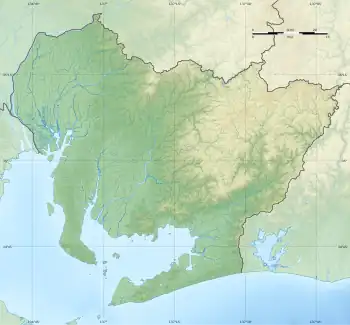| Battle of Ukino | |||||||||
|---|---|---|---|---|---|---|---|---|---|
| Part of the Sengoku period | |||||||||
 Iwakura House | |||||||||
| |||||||||
| Belligerents | |||||||||
|
|
| ||||||||
| Commanders and leaders | |||||||||
|
Oda Nobunaga Oda Nobukiyo Maeda Toshiie Niwa Nagahide | Oda Nobukata | ||||||||
| Strength | |||||||||
| 2,000+1000 Nobukiyo reinforcement | 3,000 | ||||||||
| Casualties and losses | |||||||||
| light | 1,250 | ||||||||
 Location within Aichi Prefecture  Battle of Ukino (Japan) | |||||||||
Battle of Ukino (July 12, 1558) was the final victory of Oda Nobunaga in his struggle to unite the province of Owari against his cousin, Oda Nobukata, deputy governor of northern Owari.[1][2]
Background
After defeating Imagawa clan of Suruga in the battle of Muraki and capturing southern provincial capital of Kiyosu (both in 1554), Oda Nobunaga united the Southern Owari under his rule. In 1555, Saitō Dōsan, Nobunaga's father in law and ally, retired as the lord of Mino Province (north of Owari) for his eldest son, Saitō Yoshitatsu. However, on January 4, 1556. Yoshitatsu killed his two brothers, leading to a military conflict with his father. Nobunaga supported Dōsan, but Yoshitatsu defeated and killed Dōsan in battle in April 1556.[1][2]
Seeing the fall of Nobunaga's father in law as an opportunity, Oda Nobuyasu of Iwakura Castle concluded a pact with Yoshitatsu and opened hostilities against Nobunaga.
After resolving internal struggle and rebellion in his own family, defeating his younger brother Oda Nobuyuki who supported by Oda Nobuyasu in the battle of Ino (in 1556), Nobunaga was firmly established as the ruler of the southern Owari, while the northern part of the province was still the domain of his cousin, Oda Nobukata (successor of Oda Nobuyasu) of Iwakura castle, deputy governor of the northern Owari.
Battle
Nobunaga with support of his cousin, Oda Nobukiyo of Inuyama, defeated the forces of the Oda Nobukata (the lineal successor of Nobuyasu) of Iwakura at Ukino in Owari on August 24, 1558 (Japanese calendar date: Eiroku era: 1st year, 7th month, 12th day).[1][2][3] as result, Oda Nobukata retreat to Iwakura Castle.
Aftermath
In 1559, Nobunaga besieged, captured, and razed Iwakura Castle to the ground, ending the Iwakura branch of the Oda family and finally uniting the whole province of Owari under his rule. Later that year Nobunaga visited Kyoto and was received by Shogun Ashikaga Yoshiteru, gaining the formal appointment of deputy governor (shugodai) of Owari.[1][2]
References
- 1 2 3 4 Chaplin, Danny (2018). Sengoku Jidai. Nobunaga, Hideyoshi, and Ieyasu : three unifiers of Japan. [United States?]. pp. 55–63. ISBN 978-1-9834-5020-4. OCLC 1111714915.
{{cite book}}: CS1 maint: location missing publisher (link) - 1 2 3 4 Ōta, Gyūichi (2011). The chronicle of Lord Nobunaga. J. S. A. Elisonas, Jeroen Pieter Lamers. Leiden: Brill. p. 3. ISBN 978-90-04-20456-0. OCLC 743693801.
- ↑ Date converted from Japanese calendar to Gregorian calendar with online Kanreki Calendar Converter.
Literature
- Chaplin, Danny (2018). Sengoku Jidai. Nobunaga, Hideyoshi, and Ieyasu : three unifiers of Japan. Createspace Independent Publishing Platform. pp. 55–63. ISBN 978-1-9834-5020-4. OCLC 1111714915.
- Ōta, Gyūichi (2011). The chronicle of Lord Nobunaga. J. S. A. Elisonas, Jeroen Pieter Lamers. Leiden: Brill. p. 3. ISBN 978-90-04-20456-0. OCLC 743693801.
- Turnbull, Stephen R. (2005). Samurai commanders. Oxford: Osprey Publishing. p. 6. ISBN 1-84176-743-3. OCLC 60834971.
- Turnbull, Stephen R. (2002). War in Japan 1467-1615. Oxford: Osprey. p. 18. ISBN 1-84176-480-9. OCLC 50564411.